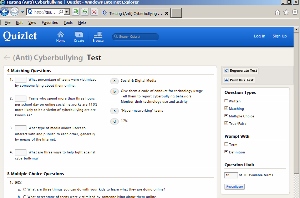AECT Standard 5: EVALUATIONCandidates demonstrate knowledge, skills, and dispositions to evaluate the adequacy of instruction and learning by applying principles of problem analysis, criterion-referenced measurement, formative and summative evaluation, and long-range planning.
Artifact 1Auto-Correcting, Differentiated Assessment: http://quizlet.com/15705864/test/ Indicators5.3.1: I developed evaluation criteria and performed needs assessments to select and implement a variety of formative and summative assessments for a unit of instruction; the artifact is one of several assessments in the unit. The assessment can be altered by the user and used in different game formats. Context:This quiz is generated using Quizlet, a web 2.0 study and assessment tool. Quizlet allows the student to generate a test within the parameters set by the instructor. This link/quiz is a part of the assessment for the Anti Cyberbullying online lesson/Bookbuilder book discussed earlier in the portfolio. The artifact, therefore, is one piece of a series of formative and summative assessments that begin embedded in the book and include a paper based assessment, matching/scatter game, and other activities. Also included was an evaluation of instruction that was used to modify the lesson.Conditions:Our group had an extended period of time to complete the project and the Bookbuilder tool was recommended/required. However the choice of assessment and the use of instruction evaluation tools was up to the group who made a decision base on our assessment of the goals of instruction, learner characteristics, and the flexibility/limitations of available technology.Scope:The assessment is available for use at Quizlet and the Title I website when the lesson/Bookbuilder book is embedded. I may choose to update the lesson and the assessments at a future date.Role:As the team member designated the content expert I took a leading role in evaluating possible assessment tools and informing the design team about the criteria the assessment is designed to measure, the learners, and relevant technical limitations.Artifact 2Mini-Redesign Project: http://www.shelbyesimmons.me/miniredesign/ Indicators5.1.1, 5.2.1: Using my understanding of learning and instructional design theories and models, I developed and discussed criteria to evaluate an instructional tool and performed a re-design to improve the instruction. Context:When working as an instructional designed the ability to re-design or build upon the work of others is very important. This artifact documents the re-design of an instructional PowerPoint created by Cary Lee, an educator who made a PowerPoint on Fractions available online. The artifact documents the issues I found with original PowerPoint based on criteria gleaned from various sources detailed in the artifact. The artifact contains 4 linked webpages showing the three ADDIE-related phases of the project Analysis, Design, and Development. Criterion-based Evaluation related to learner characteristics, goals, and other concerns, are included in each phase.Conditions:The original source for the redesign had to be publically available and the content needed to be a PowerPoint with fewer than 20 slides. The before and after had to be shown in a slide show and the criteria for each change had to be explicitly documented.Scope:The artifact is available online via the included link, I have not implemented the instruction, the original instruction tool/PowerPoint was implemented.Role:The mini-redesign was a solo project.Artifact Navigation:Design - Development - Utilization - Management - EvaluationDownload Required Programs - Back to top |
Performance Indicators5.1 Problem Analysis 5.1.1 Identify and apply problem analysis skills in appropriate school media and educational technology (SMET) contexts (e.g., conduct needs assessments, identify and define problems, identify constraints, identify resources, define learner characteristics, define goals and objectives in instructional systems design, media development and utilization, program management, and evaluation). 5.2 Criterion-Referenced Measurement 5.2.1 Develop and apply criterion-referenced measures in a variety of SMET contexts. 5.3 Formative and Summative Evaluation 5.3.1 Develop and apply formative and summative evaluation strategies in a variety of SMET contexts. |

